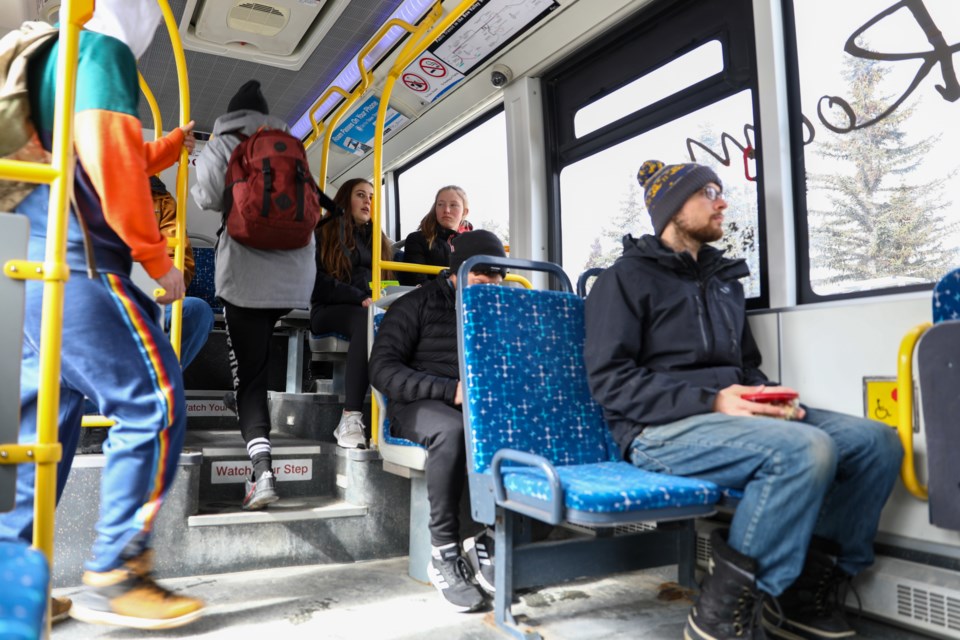BOW VALLEY – Roam Transit will require all passengers on its buses in the Bow Valley to wear face coverings beginning next week.
The Bow Valley Regional Transit Services Commission, which operates transit in the area, made the proactive decision to become the first transit agency in Alberta to make it mandatory for passengers on public transit to cover their faces as of July 13.
Chief administrative officer Martin Bean said since the beginning of the pandemic, Roam has been encouraging the use of face coverings and non-medical masks on local buses.
"We decided to take the proactive step and mandate [face coverings] in the hopes of ensuring people's comfort while riding transit and being able to increase ridership safety and comfort for passengers," Bean said.
"It is an additional safety measure and all along Alberta Health Services has recommended the use of face coverings in areas like transit where you cannot keep two metres of separation.
"We decided to make it mandatory with the hope that we get a high level of compliance."
Bean said the decision supports increased safety and prevents or limits the spread of COVID-19 in the Bow Valley. There are, however, some exceptions, including children under the age of two, those with an underlying medical condition that prevents them from covering their face and those who are unable to place or remove a face covering without assistance.
Roam bus drivers are not required to wear a face covering when they are behind a Plexiglass barrier, or if they are wearing a face shield.
Bean said passengers have indicated they are more comfortable when more people are covering their faces on public transit. Mandating face coverings is in addition to increased cleaning and sanitizing on Roam buses – before and after buses are in use and during the operations.
"At this point we are maintaining our ridership at 60 per cent capacity," Bean said, adding for the first two months of the pandemic ridership was further reduced in terms of capacity to allow two metres of separation between all passengers.
Roam Transit has been working with the Canadian Urban Transit Association to understand what other jurisdictions are doing to prevent the spread of COVID-19. Bean said in Ontario and Quebec, face coverings are now mandatory to ride on certain public transit systems.
As of Monday (July 6), Alberta Health Services geospatial data showed zero active cases in Banff, Canmore and the MD of Bighorn region. Since the middle of March, five cases in Banff have recovered and 28 in the Canmore and Bighorn region.
Face coverings that can be worn on Roam Transit buses includes: non-medical masks, headwraps, bandanas and scarves. Passengers are encouraged to still maintain a two-metre distance from one another whenever possible.
The Alberta government is also preparing to distribute more free non-medical face masks to the public. Bean said he expects to receive disposable masks from Alberta Health in the near future that would be available as a supplementary supply if someone wishing to take transit did not have one.
Roam Transit routes for summer 2020 are also somewhat different this year due to the coronavirus. Canmore local, Canmore-Banff regional and Banff local routes, with the exception of the route to the Banff Centre for Arts and Creativity, are running normally.
However, routes to Minnewanka Lake, Johnston Canyon and the scenic route to Lake Louise are no operational this year.
Bean said operating public transit during a global health crisis and its economic fallout has been challenging, but the goal has been to maintain Roam's service for locals.
"We have built Roam Transit to allow people in the valley to live without a vehicle," he said. "Our goal through this has been to still provide service for essential workers to get to work and make trips to the grocery store, doctor's office and pharmacy – to ensure that transit options are available."
With visitation increasing in Canmore and Banff due to regional travel as restrictions have been lifted during Alberta's economic relaunch strategy, Bean said the transit agency could respond if needed with increased routes or capacity.
Even if ridership numbers increase for the summer, however, Roam Transit and its municipal government partners are facing increased costs as a result of COVID-19. Bean said the Canadian Urban Transit Association continues to lobby the federal government for financial support for the sector.
"It has been a bit of a challenge and we are still hoping for some additional funding for transit agencies to come from the federal government to help out with the revenues lost," Bean said.
Go to Roam Transit's website for more details.




